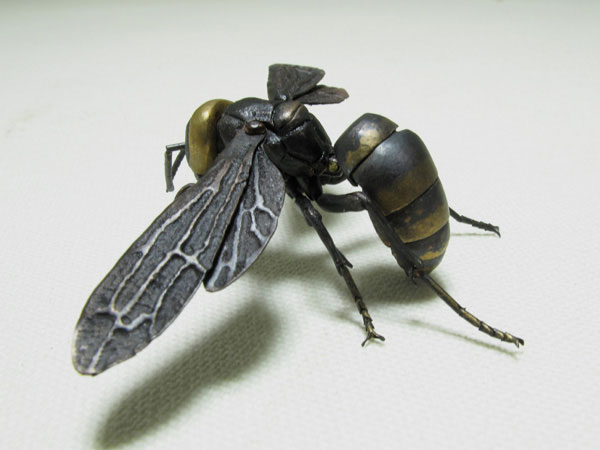Copper Brass Gold plated
2009
Date&Material
For whom are they…?
The Japanese giant hornet (Vespa mandarinia japonica), colloquially known as the yak-killer hornet, is classified in the order Himenoptera, the family Vespidae, is the world’s largest hornet, with ferocious character, organizes the huge society centered around the queen; to protect that, it attacks even large animals.
They are the most dangerous wild animals in Japan, as the fact that the death toll caused by their stings exceeds that of wild bears and venomous snakes.
The Japanese common name of which 雀蜂 Suzumebachi literally means sparrow hornet, is from its size reaching a sparrow’s, or the color of their hive resembles to sparrows’ color; however, thus depends on the districts, as there are other names e.g., “Kumanbachi”, ‘Kamebachi’, etc…
Especially, “Kumanbachi” is widely used in Japan, but that is merely used as a generic term for hornets to be distinguished from bees.
The subspecific name “mandarinia” is from its warning color likened to the bureaucrats of Qing Dynasty (the last ruling dynasty of China) wore the gorgeous uniforms. “Vespa” is a Latin word means hornet.
The impression that they make the meatballs of insects (e.g., grasshoppers) and their ferocious looking, make the belief that they are insectivores, yet the feeds are not their preys; they feed mainly on the clear liquid (vespa amino acid mixture) produced by the larvae which feed on the meatballs made and supplied by the imagos..
The other staple foods of the imagos are mushrooms and honey…etc, unexpectedly peaceful, on the other hand, they are merciless to the preys, especially from July to August (the peak of insects’ emergence) they crunch even hard beetles such as scarab beetles into pastes by their mandibles to make the meatballs.
Another great characteristic of them is “Mass Attack”, is their distinctive behavior that forms a group to devastate colonies of honey bees or other hornets, and steel the larvae and pupae from the victims’ hives to their own; thus is peculiar to the Giant Hornet.
The hive is composed of honeycomb cells horizontally aligned, coated by beeswax. The cavity wall of which is made of propolis, is a resinous mixture collected from tree buds, sap flows, or other botanical souces by the hornets each individually collect the materials and construct a part of the hive, therefore the process seems like fish scales growing and overlapping the surface.
The venom is a complicated mixture of biologically active substances, called "The toxic cocktail", mainly consists of: histamine, serotonin, hornet kinin, mastoparan, mandaratoxin, vespa kinin, phospholipase, protease, etc…
The stinger, poison sac, poison gland of hornet are developed from the female's sex organ, thus indicates the male dose not sting, and this is same as the other kind of bees and hornets. The queen also has the stinger, yet is less offensive and hardly stings.
Inspect of the fearful impression mentioned above, traditionally hornet has a connection with our life, for instance, is to be used for extermination of harmful insects by exploiting its habit of making meet ball of insects which include harmful one.
In Kampô (the Japanese study and adaptation of traditional Chinese medicine), hornet’s hive is used as a medicine called 露蜂房Roboh-Boh means the wet hornet hive resulting from rain; the usage is pulverizing it into a powder, or, roasting it to make the decoction, which is sometime taken with alcohol; thus is said that decomposes toxin, heals spasm, induces sedation.
In some areas in Japan, there is the custom to hang the hive that no longer hornet lives in under the eaves as a talisman. Another custom is to worship the hornet Vespa simillimaxanthoptera of constructing the huge hive under the eaves, is called 長者蜂 Chôja-Bachi (literally means the wealthy hornet), and believed that brings good luck, not to be stimulated to co-exist well.
To make this work, I depict the color of the hornet with gilt, and made its legs, mandibles, bottom to be movable. Moreover, its distinctive stinger was made to spring out that is corresponding to its abdomen's movement, incidentally, to think this gimmick took me 3 days.
